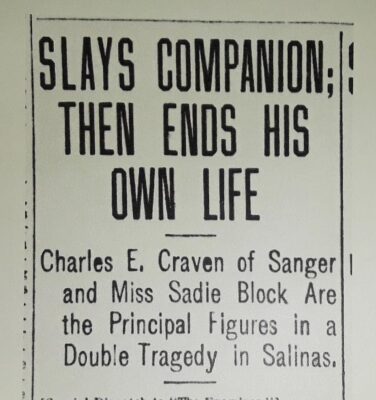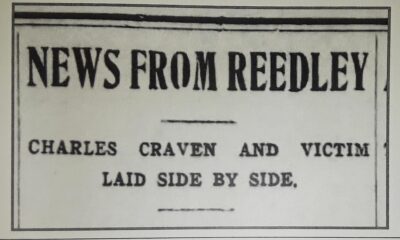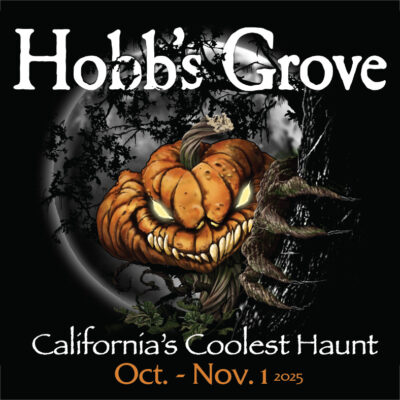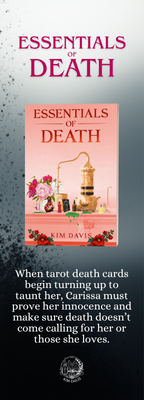by Sarah A. Peterson-Camacho
“I shall accompany her into eternity, and ere this is read, we shall have launched our bark upon the sea of death.” —Charles Benton Craven, Thursday, July 16, 1903
Blood saturated every surface: splattered across the walls, soaking through the bedsheets. Arterial spray darkening from ruby to rust, placing the precise time of the murder-suicide some twelve hours prior. The nude forms of a young man and woman faced one another on the bed, their expressions serene despite the gaping mess of their flayed throats. Hers had been cut just above the clavicle, his severed at the Adam’s apple. A bone-handled razor lay at his side, slick with clotted crimson.
In the wee hours of Thursday, July 16, 1903, the young couple had returned to their quarters at the Arno House, one of the more notorious brothels in Salinas, California. Greeted by madam and landlady Effie Lewis in the front parlor, the pair quickly retired for the evening, even though it was already two in the morning. “‘I was up until about five o’clock and heard no peculiar sounds,’” Lewis related at the inquest the afternoon of Friday, July 17, “‘although I could hear them talking, but did not know what they were saying’” (“A Ghastly Find,” 1903).
When the couple failed to appear by midday, and did not answer the door when she knocked, Lewis summoned the police. She stood by as Deputy Sheriff H.E. Davis forced open the door, raising the curtains on a crime scene so bloody, it brought to mind the heinous deeds of Jack the Ripper. Noting the empty laudanum bottle and wine flask tucked discreetly beneath the bed, Davis concluded the young woman had been drugged before her throat had been slit, rendering her unconscious—and therefore, incapable of fighting off her attacker. And on a commode at the head of the bed, the deputy sheriff found a letter addressed to the young man’s parents.
“‘This is the second time I have found my wife, Frederika Pearl Craven, in a house of prostitution,”’ wrote the murderer, “‘and in my desperation, I am determined to put a finale to the wicked life she has led.’” (“Dies with His Erring Wife,” 1903).
The killer was none other than Charles Benton Craven, the eldest son of prominent Central Valley cattleman Joshua Benton Craven, one of Fresno County’s earliest settlers. The sensational story proved too intoxicating for California newspapers to pass up—a wealthy son of privilege undone by his love for a beautiful prostitute. It had all the elements of an epic murder ballad: sex, drugs, deception, and the ultimate crime of passion.The papers ran with it, outdoing themselves with melodramatic headlines: “A Ghastly Find.” “Shocking Tragedy.” “Crime Closes Hapless Romance.” “Killed Mistress, then Himself.” “Drugged Victim Before Murder.” “Illicit Love the Cause of the Crime.” No journalism tactic was deemed too unethical to not resort to; the San Francisco Chronicle even excerpted portions of Charles Craven’s suicide note. But even more troubling was the steady stream of insulting headers, blaming the victim for her own bloody demise: “Girl’s Wayward Life Caused His Crime.” “Killed Her that She Might Not Live in Shame.” “Reform No Doubt Permanent: young man kills young woman because of her method of living.” “Note Says Her Immoral Conduct Prompted Act.”
Not one of the periodicals could even decide what her real name was. The moniker most mentioned was Sadie Block, but variations abounded: Sadie Black. Pearl Black. Pearl Bloch. Wilifred Pearl Bloch. In fact, the only detail the press could unanimously agree upon was that the slain young woman’s father was the president of the Bloch Manufacturing Company of Richmond, Virginia. Except that no such company actually existed.
Frederika Pearl Bloch was born around 1881 or 1882, the first-born daughter of West Virginia tobacco tycoon Samuel S. Bloch and his wife Bertha. She grew up amid a veritable whirl of wealth and privilege as the daughter of the co-founder of Bloch Brothers Tobacco Company, best known for its Mail Pouch chewing tobacco.
Alongside her younger sisters Madelyne and Dorothy, Sadie—as she was known—was one of the darlings of Wheeling, West Virginia, high society, while her brothers Jesse and Harold followed in their father’s footsteps, learning the ins and outs of the cutthroat tobacco trade. But while her sisters went on to marry into even more wealth, and her brothers to dabble in politics and professional golf, Sadie dropped out of society in her late teens to become a denizen of the demi-monde, or “half-world.” But exactly when, how, and why remain a mystery.
What is know is that by 1903, Sadie, about twenty-one, was in California, crossing paths with twenty-three-year-old Charles B. Craven, the oldest son of a wealthy Sanger rancher, who had settled near the Kings River around 1870. But tragically, this young man would soon prove to be the very death of her.
Born to Joshua B. Craven and his wife Virginia in January of 1880, Charles was heir to his father’s self-made fortune, hundreds of acres of land and livestock, but he just didn’t show any interest in learning the tricks of the Craven trade. Instead, the eldest Craven son was a rather dreamy young man, a dangerous romantic prone to women and whiskey. So, was it really that much of a surprise when he left the Valley for the bustling allure of the Bay Area?
Settling in the scenic neighborhood of Point Richmond in the East Bay, Craven opened a saloon called the Hoffman House, with his best friend and business partner F.B. Woods. It was here that he fell head over heels for Miss Sadie Bloch, who was soon living as his wife—though in name only.
Their relationship proved to be “a stormy one. On more than one occasion, their passages of love were punctuated with pistol bullets, the woman doing the shooting, impelled it is said by an insane jealousy” (“Light on Tragedy,” 1903). But no matter how often his friends and acquaintances advised him to cut her loose, Craven said that he would rather be dead than live without her (“Light on Tragedy,” 1903). By the spring of 1903, Craven instead cut himself loose, selling out his share in the saloon to Woods, and headed south with Bloch on what would be the last leg of their shared journey.
According to the suicide note he had left for his parents, Craven was determined to marry and make a proper lady out of Sadie Bloch, after having found her holed up in a brothel. But apparently, he wrote, not even a ring on her finger could keep her virtuous; she simply wasn’t interested in what he had to offer, so he would accompany her to the grave—rather than abandon her to the paid company of other men.
Craven then requested that their bodies be buried side by side in Reedley; oh, and their marriage certificate could be found in their room, proof that he had tried to make an honest woman out of her…at least before resorting to laudanum and a bone-handled razor. But an air of corruption permeated the whole messy affair, as journalists were keen to point out in their search for the absolute truth.
“The facts in connection with the double tragedy of yesterday are coming to the surface, despite the efforts of County Coroner H.V. Muller to suppress all information,” noted The Oakland Tribune (“Facts of Double Tragedy are Revealed,” 1903).
Charles Craven’s Central Valley brethren had no idea who Sadie Bloch even was, but that didn’t stop them from intimidating a former local lover of Craven’s into keeping quiet.
“For awhile an impression prevailed that the Black woman was a person who was formerly acquainted with young Craven in Sanger,” declared The Fresno Morning Republican two days after the murder-suicide, “but this person was seen in Fresno yesterday, though she had been warned out of town a short time before.” (“Salinas Tragedy,” 1903).
And though Craven’s father, out on a cattle drive, had not yet been informed of his son’s fatal indiscretions, “the remains of Charles B. Craven and the woman whom he murdered were shipped to Sanger, Fresno County, on the early train this morning,” the Salinas Californian reported Saturday, July 18. (“Shipped to Sanger,” 1903).
As the bodies were laid to rest side by side in Reedley the morning of Sunday, July 19, a most blatant falsehood was published in The Fresno Morning Republican. “The coroner of Monterey County was called up by telephone yesterday by a representative of the family,” claimed the Republican, “and said that young Craven had lived an excellent life while in Salinas, and had been perfectly respectable in his associates.” (“The Craven Funeral,” 1903).
That coroner was none other than H.V. Muller, who had already been accused by multiple papers of attempting to “suppress all information” regarding the particulars of the murder-suicide, and the Craven family “representative” was most likely Charles Craven’s brother-in-law, Fresno County Supervisor William D. Mitchell, who would die in jail in 1928, serving out a term for corruption and fraud.
So, Frederika Pearl Bloch shares a grave with her murderer in Reedley Cemetery, in the Craven family plot, though no marriage certificate was ever found. Sadie could not escape her killer’s company even in death, as she had tried so desperately to do in life, fleeing from brothel to brothel in a futile attempt to reclaim her own identity—one apart from an abusive and controlling partner.
Tragically, Charles B. Craven appeared to have the final word on the whole despicable matter when a letter he had written to a friend surfaced in The Californian, detailing his heinous plot.
“Salinas, July 10, 1903…Sadie has been a bad actor again. She has gone to the Arno and you know what that is…We were in Hollister for a while and she promised me to live straight. To keep her that way, I married her before a justice of the peace, but God knows it ain’t done no good. I guess it will all end some day before long, and if you hear of anything happening to me, you will know the reason…This may be the last letter I shall write to you…Your friend, Charlie.”
Bibliography
“A Ghastly Find.” The Californian, Friday, July 17, 1903, p. 3.
“Dies with His Erring Wife.” The San Francisco Chronicle, Friday, July 17, 1903.
“Facts of Double Tragedy are Revealed.” The Oakland Tribune, Friday, July 17, 1903.
“Salinas Tragedy.” The Fresno Morning Republican, Saturday, July 18, 1903.
“Shipped to Sanger.” The Californian, Saturday, July 18, 1903.
“The Craven Funeral.” The Fresno Morning Republican, Sunday, July 19, 1903.
“Light on Tragedy.” The Californian, Tuesday, July 21, 1903, p. 3.
“Charles Craven and Victim Laid Side by Side.” The Fresno Morning Republican, Friday, July 24, 1903, p. 7.
“W.D. Mitchell, Former Banker, Dies in Prison.” The Fresno Morning Republican, Friday, Nov. 16, 1928, p. 11.
www.findagrave.com.
Guinn, J.M. History of the State of California, and Biographical Record of the San Joaquin Valley, California. Chicago: The Chapman Publishing Co., 1905.





















Fascinating